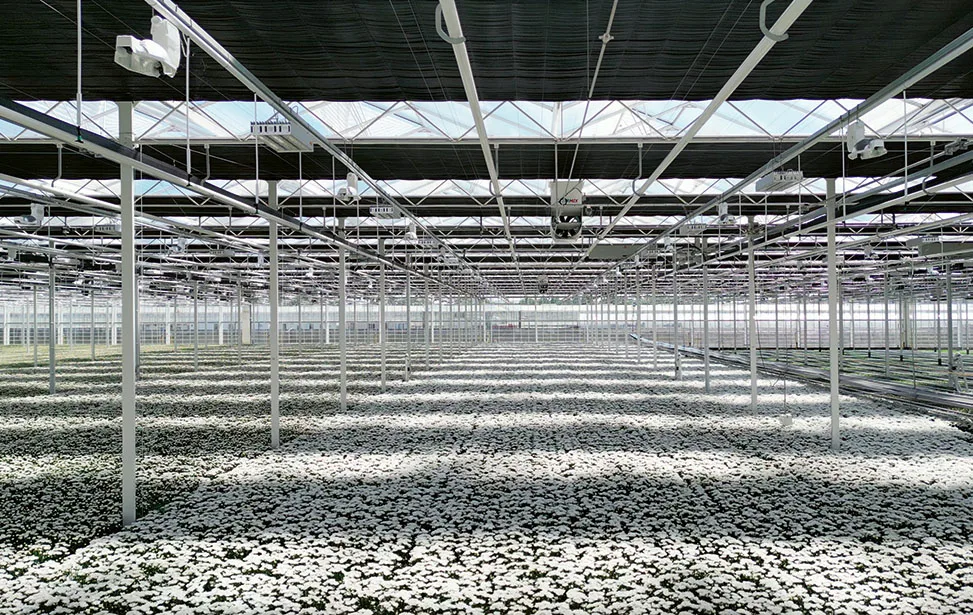- English

The owners of Linflowers describe themselves as ‘strong bloomers’ with a long family history, who are constantly evolving and always looking for unique varieties of chrysanthemums. David, Rochus and Leendert van Tuijl are a passionate team who like to stay ahead of the curve. This is shown by their state-of-the-art nursery, with four locations in the Bommelerwaard region in the middle of the Netherlands. Here they grow a wide variety of high-quality chrysanthemums on 22 hectares. Their new 7.2-hectare facility was completed in 2021. In this brand-new greenhouse, the chrysanthemum growers wanted to install a blackout screen with an aluminium top layer, which is also fire retardant. This led to them to choose Ridder’s RBO 100 FR AB+B blackout screen and Ridder’s RBO 100 R FR W rolling wall screen.
Advantages of aluminum
“When we started building this greenhouse, we were looking for a screen fabric that combined fire retardancy with an aluminium top layer. That didn’t exist yet. The closest thing we could find was a screen fabric with a white top layer. We then asked manufacturers if they could develop the fabric we wanted,” says David van Tuijl from Linflowers. It was Ridder, working in partnership with Holland Scherming, which rose to the challenge and designed a fabric that met all our qualifications. The aluminium top layer was so important to the chrysanthemum growers, because of its higher insulation value and the positive effect this has on the moisture balance in the greenhouse.
“Aluminium reflects sunlight better than a white screen fabric. This screen keeps the greenhouse cooler in summer and warmer in winter.” The chrysanthemum grower says one of the main disadvantages of using a screen with a white top layer is that it causes condensation to form on the plants in cold winter weather. “This is because this fabric gets colder and the collision with the warm greenhouse air causes moisture to form.”
Flowering autumn flower
The use of a blackout screen is essential in the cultivation of chrysanthemums. The Van Tuijls family definitely prefer a screen fabric with an aluminium outer layer. “The chrysanthemum is an autumn flower, which blooms when the night is slightly longer than the day. We maintain these conditions year-round by closing the blackout screen for 13 hours a day, explains David. He was a bit apprehensive about choosing the new Ridder screen without it being extensively tested in the field. “Will shrinkage be a problem? And will the screen be resistant to wear and tear? Time will tell. But when I see how the fabric performs and retains its structure, I am very happy with it.” Ridder guaranteed to provide extra aftersales care and to closely supervise the installation of their innovative screen. This finally convinced the grower to take the plunge.
10 percent savings
After the first winter of growing chrysanthemums under the new screen, David can already report significant energy savings. “We estimate that we’re saving about 10 percent more energy compared to our greenhouse built in 2014. This has a screen with a white top layer. We mainly see a difference in heat usage during the night. After several seasons, we will have enough data to confirm this.”
Dehumidification
For chrysanthemum growers, it is a challenge to remove enough moisture from underneath a blackout screen that is heavily insulating. This is difficult to achieve without air hoses or a dehumidification system, says David. “We use Airmix units, which can suck in air from above through an opening in the screen. This has proved to be an excellent combination with the Ridder screen.”
Linflowers does not expect their business to expand in the coming years, but their current greenhouse nurseries will undergo modernization from time to time. “Our oldest greenhouse still uses a non-fire-retardant screen. If our experiences stay the way they are, we will eventually replace it with this new blackout screen.”